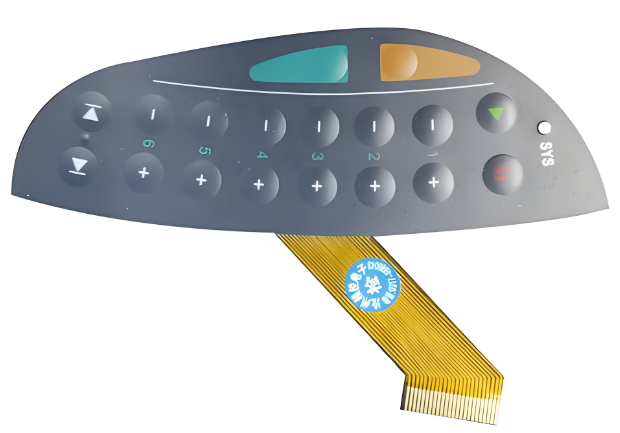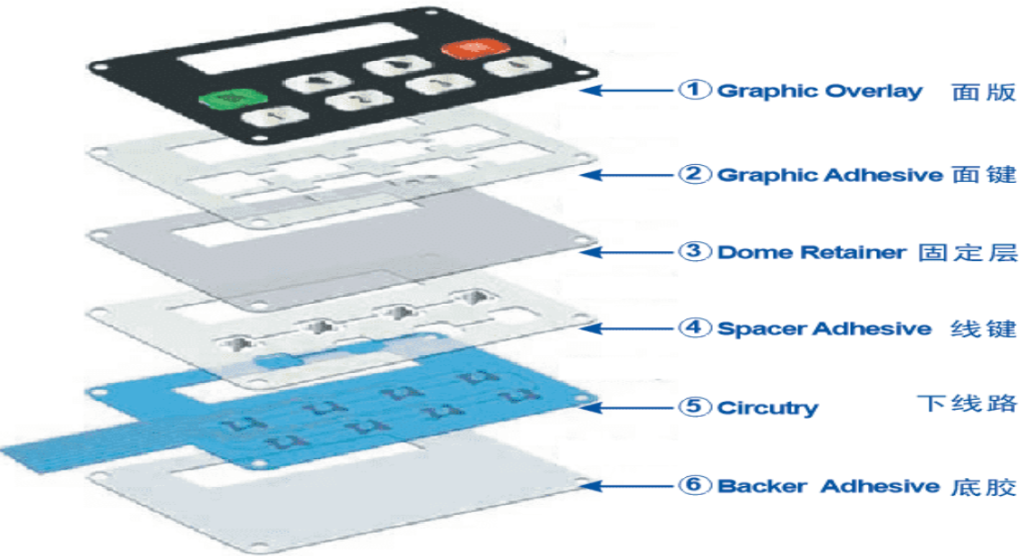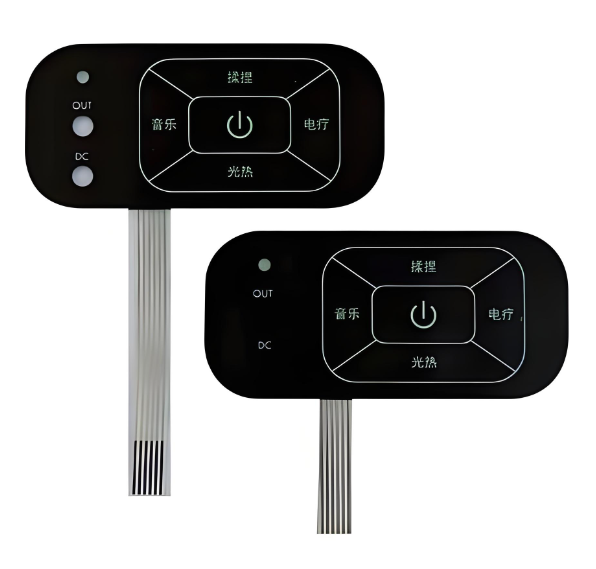
What Is a Graphic Overlay?
What Is a Graphic Overlay?
What Is a Graphic Overlay?
A graphic overlay is the visible top layer of a device or equipment interface, commonly found in membrane switches and control panels. It acts as the user-facing element, conveying information and guiding users through visual cues like text, symbols, and colors. Made from durable materials, graphic overlays are both decorative and functional. They often include instructions, branding elements, or operational indicators for seamless user interaction.

Types of Graphic Overlay
Graphic overlays come in various types based on their application and design. Some common types include:
- Flat Graphic Overlays: These overlays are simple and smooth, designed for basic applications without the need for tactile feedback.
- Embossed Graphic Overlays: Featuring raised areas, embossed overlays enhance the user experience by providing tactile feedback on buttons or key areas.
- Transparent Window Overlays: These include clear sections to display LEDs, screens, or other indicators underneath.
- Backlit Graphic Overlays: Designed for devices used in low-light conditions, these overlays allow light to shine through specific areas for visibility.
- Custom Graphic Overlays: Tailored to unique designs, these overlays cater to specific branding or operational needs.

What Does the Graphic Overlay Do in a Membrane Switch?
In a membrane switch, the graphic overlay serves as the interface between the user and the device. It provides clear labeling for buttons and operational areas, ensuring intuitive control. The overlay also protects the underlying circuitry from external damage like moisture, dust, and scratches. Here are some functions of graphic overlay in membrane switch:
- User Interface – It provides clear labels, symbols, and colors to guide users in operating the device efficiently, thanks to graphic overlay printing techniques.
- Protection – The overlay shields internal components from moisture, dust, chemicals, and wear, ensuring long-term durability.
- Tactile Feedback – Embossed or textured features in the graphic design overlay texture allow users to feel button locations, improving accuracy and ease of use.
- Branding – Custom designs with logos, colors, and graphics enhance the product’s appearance and brand identity through custom graphic overlays.
- Visibility – High-contrast printing and backlit options ensure readability in various lighting conditions.
- Customization – Overlays can include transparent windows, LED indicators, and antimicrobial coatings for specialized applications, all part of the graphic overlay design process.
- Durability – Made from materials like polyester or polycarbonate, overlays withstand harsh environments, contributing to the longevity of the switch.
- Aesthetic Appeal – Professional graphic overlay design creates a visually appealing and user-friendly interface.
What Content Is Included in a Graphic Overlay?
Graphic overlays contain a wide range of elements based on their application:
- Labels and Text: Clear instructions or descriptions for buttons and controls.
- Branding: Logos, slogans, and company details to establish identity.
- Symbols and Icons: Universal signs for quick recognition.
- Windows: Transparent sections for displays or indicators.
- Color Codes: To differentiate functions or alert users about specific actions.
- Patterns and Textures: Added for visual appeal or tactile feedback.
Each component is thoughtfully integrated to ensure a seamless user experience while complementing the device’s functionality.
What Materials Are Used in Graphic Overlays?
The choice of materials for graphic overlays depends on durability, appearance, and environmental factors. Commonly used materials include:
- Polyester (PET): Known for its durability, flexibility, and resistance to chemicals and wear.
- Polycarbonate (PC): Offers excellent optical clarity and impact resistance, suitable for high-use applications.
- Vinyl: Cost-effective and versatile, often used for simpler designs.
- Acrylic: Provides superior transparency and scratch resistance.
- Special Coatings: Additional layers, such as UV-resistant or anti-glare coatings, improve performance in challenging conditions.
If you are still confused about the material selection, welcome to contact Yuan electronics. We are a professional graphic overlay and membrane switch manufacturer in Asia, we offer top-notch technical support to our customers.

Graphic Overlay Design Considerations
Creating a graphic overlay involves careful planning to balance aesthetics and usability. Key design considerations include:
1. Color and contrast control: The modulation ratio of ink is the main cause of color deviation, and too strict color requirements will lead to higher costs. Therefore, the color range should be within a reasonable range and too small a color range should be avoided. Additionally, use high-contrast colors for readability in various lighting conditions.
2. Adhesive selection: The selection of adhesive should not only consider the quality of raw materials, but also include the shape of the prototype. If it has grooves/small slot, it is necessary to choose a good quality adhesive to ensure a strong viscosity.
3. Material selection: Use materials with good light transmission, heat resistance, impact resistance and easy processing, Yuan always uses PC and PET materials, some special material is available if customers required. Choosing the right material can improve the durability and functionality of the graphic overlay.
4. Sealing performance: The graphic overlay on membrane switch should have good sealing performance, can be waterproof and dustproof, suitable for a variety of harsh environments. Its overall sealed structure makes the membrane switch contacts not corroded by harmful gases and not easy to oxidize.
5. Tactile Features: To get a good clicky feeling, you can incorporate embossed or textured surfaces for better usability.
Custom Graphic Overlays Manufacturers – Yuan Electronics
Yuan Electronics is a leading manufacturer of custom graphic overlays and membrane switches, offering solutions tailored to specific industries and applications. Our expertise in material selection and design ensures overlays meet both functional and aesthetic needs. In our company, we emphasize quality and innovation, providing durable and visually appealing overlays that stand out. With a focus on customer satisfaction, we can deliver products that align with your exact specifications.
For reliable and high-quality graphic overlay solutions, Yuan Electronics remains a trusted partner in the industry.

Top Membrane Switches for Home Electronics Projects in 2025
You can elevate your home electronic membrane switch project in 2025 with standout models such as the 4×4 Matrix 12 Keys Keypad from SOUSHINE, the rgb-enabled strip switches from Molex, and custom graphic switches by Panasonic. These switches offer slim profiles and reliable performance, making them easy to integrate into your DIY setup. You gain ...

Top tips for fixing PS4 controller conductive film keypads
Are you frustrated because your PS4 controller buttons have stopped working? You are not alone. Many gamers experience issues with the conductive film keypad for ps4. Button failures often happen because of dirt, debris, or rough handling. Take a look at the most common causes: Cause Description Dirt and debris Accumulation in button crevices can ...

Top Membrane Switch Companies Leading the Industry in 2025
You see a dynamic market shaping the future of membrane switch technology. Leading companies like Molex, SOUSHINE, YU AN Electronics, TE Connectivity, Honeywell, Omron, Mitsubishi Electric, Panasonic, Industrial Print Technologies, SCHURTER, XYMOX, Douglas Corp, Dyna-Graphics, ELO Touchscreens, UTC, LUNFENG Technology, and Fujikura drive growth with innovation and global reach. Choosing the right membrane switch company ...
Contact us online